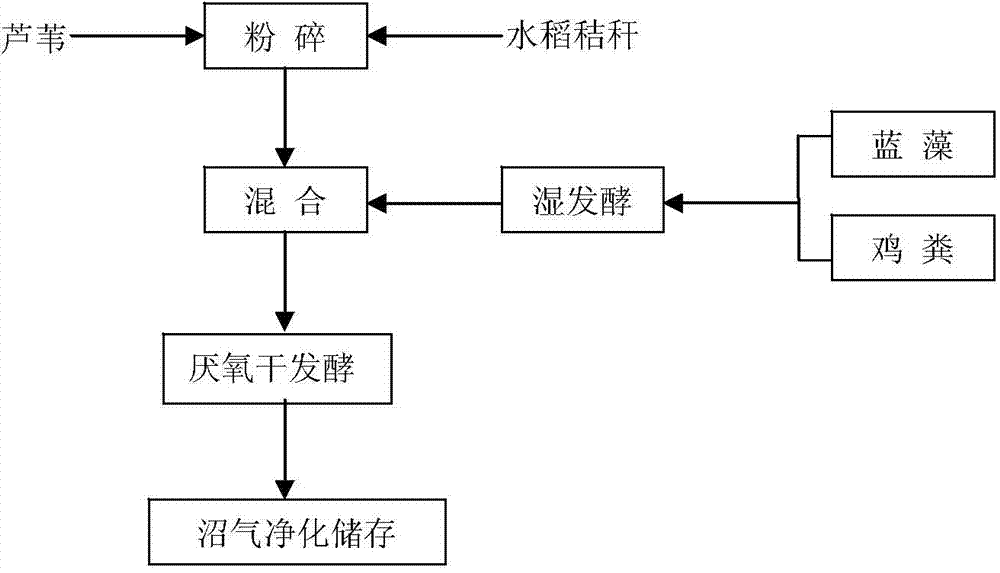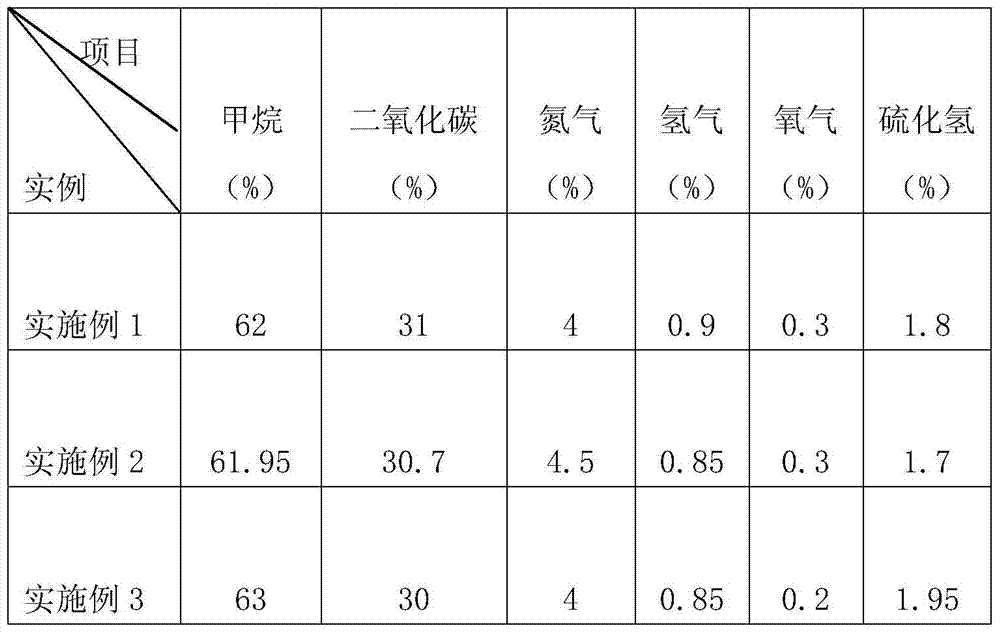Dry anaerobic fermentation technology for preparing biogas from blue algae, reed, and paddy rice straw
A rice straw, dry anaerobic technology, applied in fermentation, biochemical equipment and methods, microorganism-based methods, etc., can solve problems such as pollution of the environment, and achieve the effect of good water absorption
- Summary
- Abstract
- Description
- Claims
- Application Information
AI Technical Summary
Problems solved by technology
Method used
Image
Examples
Embodiment 1
[0025] Take 15 kg of cyanobacteria with 95% moisture content and 3 kg of chicken manure to mix for wet fermentation, and obtain biogas slurry and biogas residue for use after fermentation.
[0026] Cut the 1 / 4 stem tip part of the front end of the reed, and crush the rice straw and the cut reed stem tip into small pieces with an average length of 1cm. Mix the crushed rice straw and reed according to the mass ratio of 2:1 to obtain the crushed material for use. .
[0027] Take 9kg of the above pulverized material and the biogas residue and biogas slurry obtained after wet fermentation into the mixing device. After stirring and mixing uniformly, the materials will enter the dry anaerobic fermentation device together, and the anaerobic dry fermentation will be carried out for 30 days under the condition of 35℃ in the water bath. , 0.72m gas produced is collected 3 .
Embodiment 2
[0029] Take 15 kg of cyanobacteria with a water content of 90% and 4 kg of duck manure for wet fermentation, and obtain biogas slurry and biogas residue for use after fermentation.
[0030] Cut off 1 / 3 of the tip of the reed, crush the rice straw and the cut of the tip of the reed into small pieces with an average length of 2cm, and mix the crushed rice straw and reed at a mass ratio of 1:1 to obtain a crushed material for use .
[0031] Take 8kg of the above-mentioned crushed material and enter the mixing device together with the biogas residue and liquid obtained after wet fermentation. After stirring and mixing uniformly, the materials will enter the dry anaerobic fermentation device together. The anaerobic dry fermentation will be carried out for 25 days at a constant temperature of 25℃ in a water bath. , 0.68m of gas produced is collected 3 .
Embodiment 3
[0033] Take 15 kg of cyanobacteria with a water content of 90% and mix 5 kg of pig manure for wet fermentation, and obtain biogas slurry and biogas residue for later use.
[0034] Cut off the 1 / 3 stem tip part of the front end of the reed, and crush the rice straw and the cut reed stem tip into small segments with an average length of 4cm, and mix the crushed rice straw and reed according to a mass ratio of 3:1 to obtain a crushed material for use. .
[0035] Take 9kg of the above pulverized material and the biogas residue and liquid obtained after wet fermentation into the mixing device. After stirring and mixing uniformly, the materials will enter the dry anaerobic fermentation device together, and the anaerobic dry fermentation will be carried out for 40 days at a constant temperature of 55℃ in a water bath. , 0.62m gas produced is collected 3 .
[0036] Attached Table 1 Percentage content of biogas detection items produced by each instance
[0037]
PUM
 Login to View More
Login to View More Abstract
Description
Claims
Application Information
 Login to View More
Login to View More - R&D
- Intellectual Property
- Life Sciences
- Materials
- Tech Scout
- Unparalleled Data Quality
- Higher Quality Content
- 60% Fewer Hallucinations
Browse by: Latest US Patents, China's latest patents, Technical Efficacy Thesaurus, Application Domain, Technology Topic, Popular Technical Reports.
© 2025 PatSnap. All rights reserved.Legal|Privacy policy|Modern Slavery Act Transparency Statement|Sitemap|About US| Contact US: help@patsnap.com


